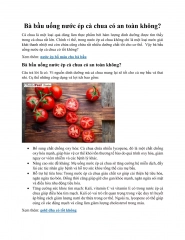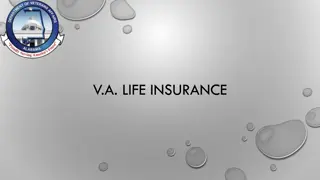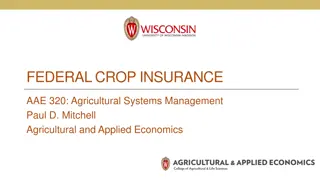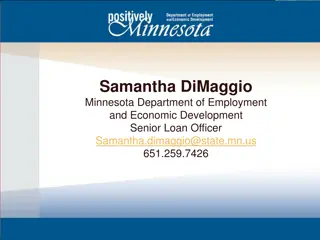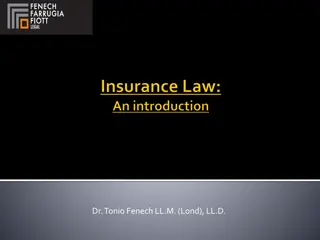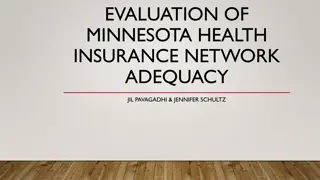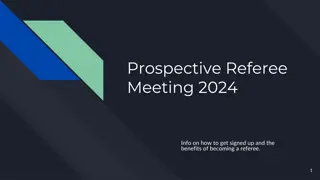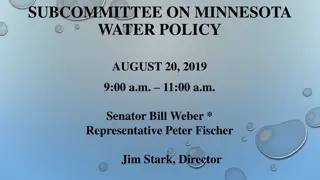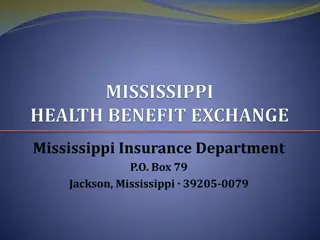Challenges and Strategies in Minnesota's HOA Insurance Market
Revealing insights into the state of the HOA insurance market in Minnesota, this content dives into the significant challenges faced by insurance companies due to wind and hail damage claims. It discusses the industry trends, mitigation strategies adopted by companies, and the impact of increasing wind/hail deductibles and cosmetic damage exclusions on policyholders.
Download Presentation

Please find below an Image/Link to download the presentation.
The content on the website is provided AS IS for your information and personal use only. It may not be sold, licensed, or shared on other websites without obtaining consent from the author.If you encounter any issues during the download, it is possible that the publisher has removed the file from their server.
You are allowed to download the files provided on this website for personal or commercial use, subject to the condition that they are used lawfully. All files are the property of their respective owners.
The content on the website is provided AS IS for your information and personal use only. It may not be sold, licensed, or shared on other websites without obtaining consent from the author.
E N D
Presentation Transcript
CAI-MN 2019 EXPO Insurance Panel Discussion
Market Update 2019 Created & Presented By: Eric Skarnes Insurance Warehouse
State of the HOA Market in Minnesota The largest volume of townhomes and condominiums in MN is located in the 7 County Metro MN is now considered a catastrophic state For every $1.00 taken in for townhome/ condominium insurance premiums, the industry pays out $1.34 in claims Each company has had varying results, but almost all companies have experienced operating at a loss in the HOA market
State of the HOA Market in Minnesota Industry wide approx. 72% of all claims paid are for wind & hail damage In MN, data has shown that complexes with over 10 buildings perform 25% worse than those with less than 10 buildings Why? More roofs, more siding = more damage Generally asphalt roofs and vinyl/metal siding have performed the worst
To Mitigate These Losses Companies Have: Pulled out of the marketplace (non-renewals) Placed a moratorium on new business Increased Rates Since Q1 2013 average rate increases have been 15%-25% a year Added separate wind/hail deductibles to polices Per building or percentage deductibles Added exclusions or endorsements to limit payout on claims
Increasing Wind/Hail Deductibles Previously common wind/hail deductibles were $5,000 or $10,000 Example: $40,000,000 Building Coverage (Coverage A) 2% Wind/Hail Deductible = $800,000 5% Wind/Hail Deductible = $2,000,000
Cosmetic Damage Exclusion Definition: Usually defined as marring, pitting or other superficial damage from hail that alters the appearance of the roof, but does not prohibit it from functioning as a moisture barrier There was a previous Matching Exclusion that attempted to do the same thing but was voided by a federal judge Previously policies paid to replace the undamaged portion of a roof or siding if they could not find the matching color and product
Cosmetic Damage Exclusion Building #1 had hail damage to the North side of their roof. Estimates show the portion of the roof that was damaged will cost $25,000 to replace. The undamaged portion of the roof will cost $75,000 to replace. The building has a $10,000 per building wind/hail deductible. Exclusion Example $100,000 ($75,000) ($10,000) $15,000 Standard Example $100,000 $0 ($10,000) $90,000 Total Damage Endorsement Deduction Deductible Total Payout
Actual Cash Value (ACV) Roof Endorsement Definition: Is the amount equal to the replacement cost minus depreciation of damaged property at the time of the loss Some carriers are moving to an Actual Cash Value endorsement instead of the standard Replacement Cost Commonly endorsed on roofs 15 or 20 years old Example: 30 year shingle was installed 15 years ago at a cost of $100,000 30 year shingle / 15 years of use = 50% depreciation $100,000 replacement cost x 50% depreciation = $50,000 total ACV payout
Actual Cash Value (ACV) Roof Endorsement Building #1 had $100,000 in hail damage to their roof. The building had their roofs replaced 15 years ago with a 30-year shingle. 15 years old / 30 year life = 50% depreciation Actual Cash Value $100,000 ($50,000) ($10,000) Replacement Cost $100,000 $0 ($10,000) Total Damage Depreciation (50%) Deductible Total Payout $40,000 $90,000
Looking to the Future Boards and property managers need to be more aware than ever when they are reviewing insurance There are certain agents that don t disclose some of the shortfalls of their policies so make sure to ask the right questions Recommend using an agent who specializes in writing HOA s HO6 policies are more important than ever
Proper HO6 Coverage Set Limits at a Minimum of Master Deductible Coverage A (Building/Dwelling) Loss Assessment Sewer/Drain (Sump Pump)
The Good News Still carriers in MN that provide great coverage & premium There are a handful of agents who specialize in writing HOA s that are happy to help If you use an HOA insurance expert, you don t need to be an HOA insurance expert yourself
Navigating the Types of Insurance Policies Created & Presented By: Trey Griffy Nesbit Agencies
Property Insurance The insurance policy that associations are most familiar with Protects an association s physical assets Buildings, Association Contents, Business Income, etc. Often combined with a general liability policy as a package Package policy may also include crime and directors & officers insurance Typically has most impactful deductible schedule Property Deductible Wind & Hail Deductible Usually includes a broad array of additional coverage inclusions
Property Insurance (Contd) Several important considerations: Your association s building limits Auxiliary buildings and structures coverage Business Personal Property coverage Percentage wind and hailstorm deductibles Property deductible: Per Occurrence vs. Per Building vs. Per Unit Sewer Backup Coverage
General Liability Protects an association from damages arising out of bodily injury or property damage that are a result of the association s negligence. Bodily Injury: Example: Slip and fall injuries Property Damage: Example: The garage door of an underground parking structure fails and strikes a vehicle while it s exiting the garage. Medical Payments Coverage: No Fault coverage for minor bodily injury claims for which proof of negligence is not required. Designed to settle claims quickly and avoid drawn out legal proceedings. Typically, no deductible for general liability claims
Crime & Fidelity Designed to protect an association s financial assets from dishonest or criminal acts committed by its employees. Crime & Fidelity Insurance vs. Traditional Fidelity Bond A traditional fidelity bond is more limited in scope. Typically defines an association s employees as board members only. A Crime & Fidelity policy expands the definition of employee to include the following (exact definition varies by policy): Property Managers Accountants & Bookkeepers Other Volunteers A fidelity bond only covers acts of employee dishonesty. A crime and fidelity policy provides coverage for a variety of criminal acts.
Crime & Fidelity (Contd) What does a crime & fidelity policy cover? Employee Dishonesty Example: A property manager discreetly opens a secondary bank account in the association s name. He or she then transfers thousands of dollars into it for his or her personal use. Forgery or Alteration Example: A board member steals several association checks and proceeds to pay out thousands of association dollars to various entities. Theft, Disappearance and Destruction Covers the loss of money and securities from inside the association s premises, or a bank due to theft, disappearance or destruction. Third Party Crime Coverage Extends coverage to 3rd parties who sustained a loss as a result of your employee s dishonest actions.
Directors & Officers Protects the board of directors from legal action brought against them for allegations of wrongful actions. Associations are especially susceptible to these allegations: Failure to properly administer board elections Discrimination Failure to adhere to the association s bylaws Challenges to assessments Failure to maintain common areas Mismanagement of association funds An association will need to defend itself, whether or not they are at fault. Defense costs are often times the most costly part of a D&O suit
Directors & Officers (Contd) Valuable D&O Coverages to Consider Defense Costs: Paid inside or in addition to the policy limit Inside: Defense costs are paid as a portion of the liability limit. In Addition to (or Outside): Defense costs are paid separately, in addition to the liability limit. Full Prior Acts Coverage Covers claims that occurred prior to the policy s inception date. Lifetime Reporting Period for Board Members Covers board members even after they have left their seat on the board.
Commercial Umbrella Provides an extra layer of liability coverage in addition to the association s primary liability limits Available to cover the following underlying policies: General Liability Directors & Officers Liability Commercial Auto Liability Employers Liability (Workers Compensation) Limits are available in million dollar increments to best suit your association s needs A commercial umbrella policy is very affordable and a great value add
Workers Compensation Designed to cover the lost wages and medical bills of employees who are injured during the course of employment If your association has employees, Minnesota laws requires you to carry workers compensation insurance Failing to do so may result in significant penalties Up to $1,000 per employee per week without workers compensation Workers compensation is not just for associations with employees Uninsured contractors working on premises may be classified as an association employee if they are injured while working for the association The cost of an if any or zero payroll workers compensation policy is less than $350 per year
How to Bid Insurance Created & Presented By: Grant Herschberger Marsh & McLennan Agency
Deciding to Remarket Reasons to Remarket Coverage Review Uncompetitive/Unreasonable Rates or Deductibles Poor Coverage by Carrier Agency Change Pros and Cons of Remarketing Pro: Review of policies, possible rate/coverage/deductible improvement Con: Carrier burnout
Remarketing Timeline 90 Days Prior to Renewal Date Contact current agent Discuss options with the Board 60 Days Prior to Renewal Date Touch base with current agent and confirm target date/pricing If remarketing, send RFP (Request for Proposal) to potential agents
Remarketing Timeline 30 Days Prior to Renewal Date Receive proposals Review with Board and send any questions or concerns to agent 7-10 Days Prior to Renewal Date Confirm Board s decision Notify agent as soon as possible
Items Needed By Agent Governing Documents Loss Runs (Currently Valued) COPE information and relevant update information Board s expectations (pricing, timing, etc.) Also helpful: Plot Map Photos Address list
Dos and Donts DO Communicate expectations with Board and agent Start the process sooner rather than later Take the time to review the quotes and ask questions DON T Mid-term quote (unless absolutely necessary) Contact too many of the same type of agents Don t get stuck on asking for apples to apples quotes
The Life of an Insurance Claim Created & Presented By: Jake Nelson Wise Insurance Agency Gavnat and Associates Dan Wennerlind
Property Claim Occurs 1. Insured Responsibility Claim reporting procedures o Time limit for reporting o Protocols should be established on reporting claims Immediate claim mitigation o Insurers may have a recommended vendor or choose your own o Vendors may have a catastrophic team available for large claim events o Time is of the essence; especially during large claim events Completion of claim documents Contractor selection / scope of work o Have contractor present at first meeting with adjuster
Property Claim Occurs 2. Carrier Responsibility Claim set-up procedures Claim assignment and inspection o Field adjuster versus desk adjuster Scope of repairs Supplemental process Claim payment procedures o Replacement Cost holdback versus ACV
Other Claims Note: All claims need to be reported to carrier immediately after any incident that may result in a claim. General Liability Employee Dishonesty Directors & Officers o Board Communication Workers Compensation o Reporting requirements per state law
Other Claims DID YOU FILE? YES NO Contact Public Adjuster Insurance adjuster inspects Policyholder contacts Public Adjuster Free inspection Agreeable estimate presented (Price/Scope) Policyholder disagrees w/ decision Adjuster denies claim/ partial coverage We investigate & create estimate No damage found No claim to be filed Make initial ACV payment Submit estimate with carrier Contractor hired/Work completed Policyholder accepts decision You file a claim Claim is closed Submit estimate Per insurance estimate We meet with Staff Adjuster Contractor submits invoice to carrier (Upper Management) Carrier makes final payment We disagree and file for Appraisal We agree and settle the claim Claim is closed Claim is closed
Appraisal Process Policyholder Invokes Right to Appraisal Demand letter sent to Insurance Company Insurance Company hires Appraiser Policyholder hires Appraiser Has 21 days to name Both Appraisers agree to Umpire Panel meets for inspection Carrier/expert present their argument PA/experts present their argument Panel reviews all info provided Panel determines award Carrier issues payment on award 2 signatures make award legally binding



